You can have the most delicious, craveable, life-changing foods and beverages on your menu, but here’s the truth: if you can’t get more customers to buy from you, you can’t grow your business. The best way to get new customers is with a thoughtful, intentional marketing plan.
We’ve put together this guide to food and beverage marketing full of proven strategies and inspiring examples from FLIP policyholders. Plus, download our free food business marketing plan today and use it to coordinate your promotional tactics!
Click to learn more about each aspect of a top-notch marketing strategy, or keep scrolling for the big picture.
What to Include in Your Food Marketing Strategy
Unique Value Proposition (UVP)
Every business needs a UVP — it differentiates you from other businesses in your area and shows customers why they should buy from you.
Your UVP could be any of the following (or something else entirely):
- A specific menu item only you offer
- Your ingredients (high quality, locally sourced, etc.)
- Customer service that goes above and beyond
- A commitment to sustainable business practices
- Unique flavors customers can’t find anywhere else
If you haven’t identified your UVP yet, consider your customers’ challenges or pain points and how your business solves those problems.
Let’s say you’re a home-based baker who specializes in custom cakes. Your customers want fancy buttercream cakes for special occasions, but they don’t have the budget to order them from a traditional bakery.
If you offer the same type of cakes at a fraction of the cost, budget-friendly buttercream could be your UVP.
Whatever your value proposition is, it needs to play a leading role in your marketing efforts. Don’t be afraid to test your messaging to learn what resonates most with customers.
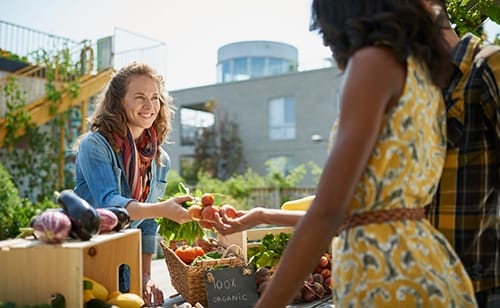
Storytelling
Did you know 68% of customers say a brand’s story has impacted their buying decision? Telling the authentic story of your business helps customers form an emotional connection with you and see you as more than just a food business.
There’s no shortage of ways to incorporate storytelling into your marketing strategy across channels and materials, including:
- Sharing how and why you started your business on your website
- Featuring customer reviews and testimonials
- Posting behind-the-scenes content on social media
- Spotlighting your team/employees
- Showcasing your community involvement
Dynamo’s Dills, a gourmet pickle-maker in Long Beach, California and a FLIP-insured business, does a great job of this on its “About” page. In just a few paragraphs, visitors learn this business is committed to providing a healthy product made sustainably.
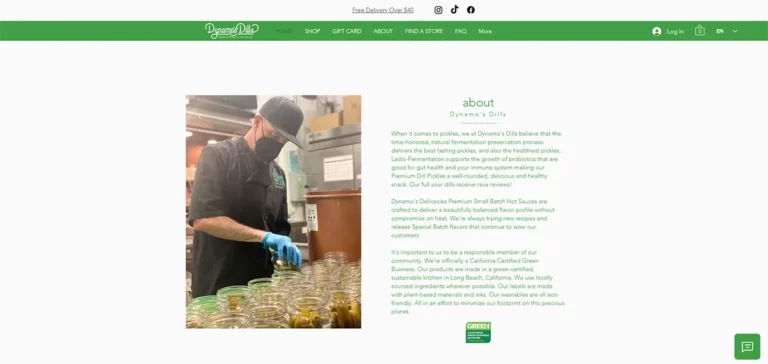
An Optimized Website
The importance of an excellent website cannot be overstated. In one survey, 32% of customers said they always check a food business’ website before buying from them, with 51% saying they sometimes check beforehand.
Your website could be someone’s first impression of you, so it plays a critical role in your marketing efforts. To capture potential customers’ attention, make sure to check off these must-haves.
Search Engine Optimization (SEO)
SEO refers to how well your website ranks in search engine results. If your site follows SEO best practices, it will be easier for people to find it if they search for relevant keywords (e.g., “Seattle catering” for a catering business in Seattle).
You don’t need to be an SEO expert to follow best practices on your site. Using a site builder like Squarespace, Wix, or Hostinger gives you access to SEO tools that analyze your site and make recommendations for improvement.
High-Quality Imagery
Fast Load Times
People have short attention spans, so if your site loads slowly, they may get frustrated and leave. This is bad for SEO because search engines prioritize sites that load quickly, and you might miss out on sales if you sell products online.
One small thing you can do to significantly impact load time is to compress images using an image optimization tool like TinyPNG or ShortPixel. Larger files can seriously hinder your site speed, so make sure you optimize each picture before you add it to your site.
Pro Tip: If you’re not tech-savvy or don’t have time to DIY your site optimization, hire a professional web designer on Fiverr.
Email Marketing
Out of all the different marketing channels, email has the highest return on investment (ROI) at $36 for every dollar spent.
Email marketing can be used to promote your business in a variety of ways, including:
- Exclusive offers or promotions for subscribers
- Welcome emails for new subscribers or first-time buyers to introduce them to your business
- New menu item or product announcements
- Invitations or alerts about upcoming events you’re participating in, such as food festivals or farmers markets
- Customer spotlights that build trust and credibility
- Surveys or requests for feedback/testimonials
- Regular newsletter for subscribers that includes updates, promotions, etc.
To build your email list, create a sign-up form on your website as a pop-up or a page during checkout if you sell products online. Offer a discount or freebie with their next purchase to incentivize sign-ups.
Pro Tip: The U.S. has laws regulating email marketing, such as requiring an opt-out option on all promotional emails. Check the U.S. Chamber of Commerce’s email marketing laws page yearly to ensure you comply with these rules.

Don’t miss our guide to marketing your food business on Instagram! It’s full of even more tips and ideas for boosting your presence on this platform and gaining new customers.
Partnerships With Influencers
Building your social media presence allows you to partner with influencers who can introduce your business to their audience.
Lifestyle influencers, in particular, are great partners for food and beverage businesses. Their content romanticizes every aspect of their daily routine, including the foods and beverages they consume.
Focus on small, local influencers with between 1,000–100,000 followers. These “microinfluencers” tend to have higher engagement rates and are more affordable than those with millions of fans.
Leverage influencer partnerships in several ways, such as:
- Pay the influencer to promote your product/service, such as a clip of them enjoying a sandwich from your food truck as part of a “What I Eat in a Day” video
- Giveaways where the influencer encourages their audience to follow your account, like a specific post, and tag someone in the comments for a chance to win something from your business, like a free dessert
- Give the influencer a special discount or coupon code to share with their followers to encourage purchases (plus, you can measure success by seeing how many customers used the code to buy something)
Pro Tip: While follower count influences how much you might pay for an influencer partnership, the platform also affects the cost. For an Instagram partnership, expect to pay between $10–$500 per post, whereas a TikTok post could cost $5–$125.
Collaborations With Local Businesses
Working with other businesses in your area is mutually beneficial, as you both gain exposure to each other’s audiences (much like influencer marketing).
Choose a business to partner with strategically. It should have similar values and complementary products to your own.
Other collaborative ideas include:
- Guest posts or features on each other’s social media accounts
- Pop-up shops showcasing both of your products
- Limited-time item (e.g., “The Book Lover’s Brew” — a special gourmet latte whose profits you split with the bookstore)
- Co-sponsor or co-host an event in your community, such as a charity gala or festival
Paid Advertisements
Every good marketing strategy involves a budget for paid advertising. While optimizing your site for SEO helps you attract organic (unpaid) traffic, paid ads allow you to target specific audiences for quicker results.
Keep the following in mind when incorporating paid ads into your food and beverage marketing plan:
- Set clear goals: Are you trying to increase brand awareness, promote a limited-time offer, improve online sales, or something else? Clearly defining your goal helps you hone your messaging and determine if your ad campaign was successful.
- Consider your ad platforms: Meet your customers where they are and run ads where they’ll see them. For example, if customer surveys show that your customers overwhelmingly use Instagram, run ads there.
- Monitor and measure your success: Track data like click-through rate (CTR), cost per action (CPA), and conversion rate to determine if an ad is performing well. If your goal with one ad campaign was to boost online sales and you don’t see many sales attributed to that ad, it might be time to pull it and try something else.
Traditional Marketing Efforts
Call them old-fashioned, but traditional marketing is still highly effective! The most successful food marketing strategies include a mixture of digital and traditional marketing for a well-rounded approach.
Some effective traditional marketing efforts include:
- Selling branded merchandise (hats, T-shirts, stickers, etc.)
- Direct mail campaigns (sending postcards or coupons to local residents)
- Placing posters in high-traffic areas, like community centers
- Branded vehicle wraps for food trucks, food trailers, and catering vans
- Loyalty programs and referral incentives
- Branded and/or unique packaging
- Business cards with your logo, contact information, website, and social media handles
Pro Tip: Gauge interest in a merch line for your business by starting with stickers. They’re inexpensive to produce compared with T-shirts and other apparel and appeal to a broad audience. Design and order stickers featuring your logo from sites like StickerYou and VistaPrint.
Inspirational Examples of Food and Beverage Marketing
Black Girl Salsa
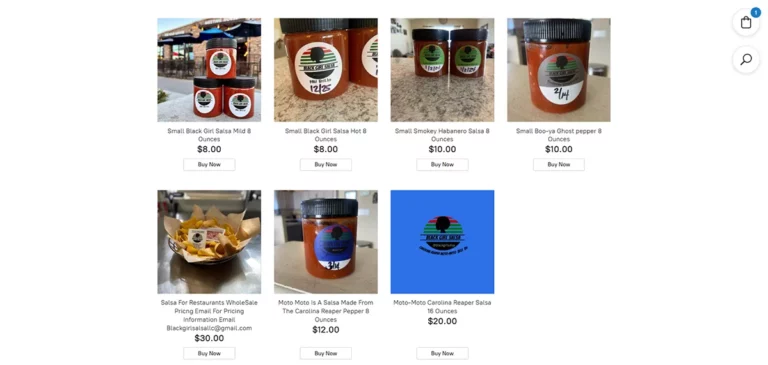
Shauna Sarkey started her business, Black Girl Salsa, during the pandemic in 2020. Within a year, a local restaurant in Colorado Springs, CO had already picked up her salsa to serve alongside baskets of tortilla chips.
What We Love About Black Girl Salsa’s Marketing Strategy:
- Easy online ordering system so you can get delicious dip delivered straight to your door
- Sarkey is open and authentic on Black Girl Salsa’s Instagram account, sharing behind-the-scenes videos of herself making batches of salsa alongside pictures of her family and happy customers
- Simple, fast-loading website that includes essential information, such as which restaurants serve Black Girl Salsa and the fact that this business is insured
Little Pearl Breads

Little Pearl Breads is a home-based bakery founded by Macey Merlak in Aurora, IL, specializing in organic sourdough and other baked goods.
What We Love About Little Pearl Breads Marketing Strategy:
- A functional, optimized, and aesthetically pleasing website with consistent branding and easy navigation
- High-quality image and video content on Instagram, including behind-the-scenes Reels and recipes infused with Merlaks’ personality
- A wide variety of valuable content that spreads brand awareness and authority, including YouTube videos and eBooks
Toadily Baked
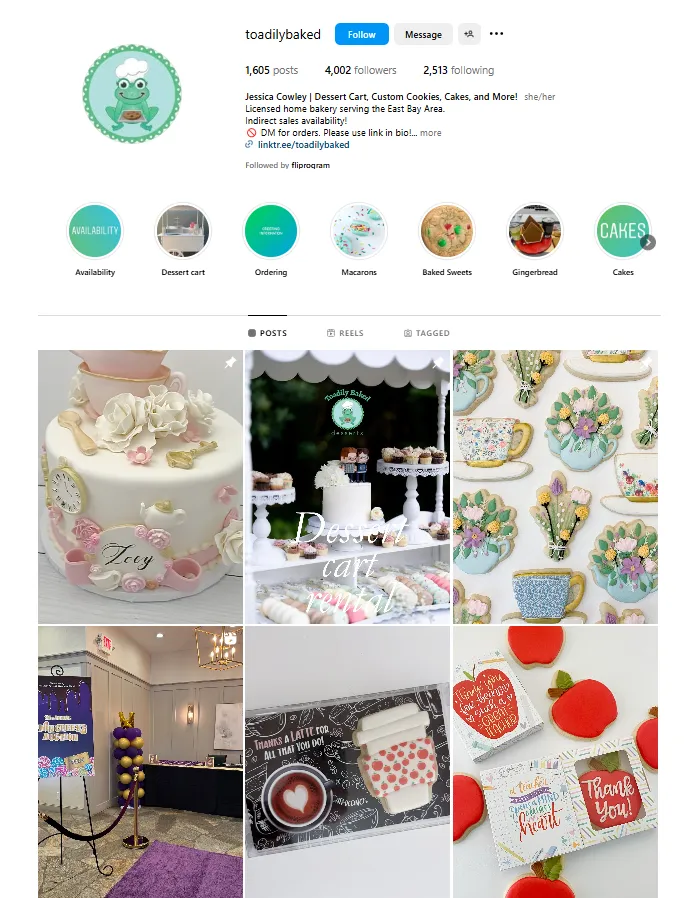
Jessica Cowley owns and operates Toadily Baked Desserts, a home bakery in San Ramon, CA. In addition to selling sweet treats, Toadily Baked Desserts offers private cookie decorating classes.
What We Love About Toadily Baked Desserts’ Marketing Strategy:
- Beautiful, high-quality images on its Instagram profile and website showcase the details of Toadily Baked Desserts’ cookies and cakes
- A marketing email strategy that allows people to sign up for promotional emails, even if they haven’t made a purchase yet
- A button on LinkTree encouraging people to leave Yelp reviews to add to social proof
Free Food & Beverage Marketing Plan Template
Take the prep work out of creating your marketing plan and download our free template! Simply enter your own marketing ideas, budget, and deadline, and update the status as needed.
Protect Your Growing Food and Beverage Business With the Best Insurance
An effective food and beverage marketing strategy helps your business grow, and liability insurance is designed to protect it from unexpected expenses that could thwart your success.
As you gain more customers and expand your business, you also take on more risk.
Collaborating with a local business to set up a pop-up shop offers incredible exposure to each other’s customer bases, but what happens if someone has a medical emergency due to an unlabeled allergen?
Getting into online sales can boost your revenue, but it also leaves you more vulnerable to cyberattacks that could compromise your (and your customers’) banking information.
Food business liability insurance can cover some or all of the resulting expenses from incidents like these, protecting your profits. It’s as essential to your success as promoting your products or services.
Learn more about how insurance from FLIP benefits your food business and how you can shield your business from the cost of risks today!
FAQs About Marketing for Food Businesses
What Are the Four Ps of Food Marketing?
The four Ps of food marketing (sometimes called the “marketing mix”) are:
- Product: What you sell or what service you offer
- Price: How much you charge for each item or service
- Place: Where you sell your product or service, including physical locations and online
- Promotion: How you advertise your product or service (paid ads, digital marketing, etc.)
Consider each of the four Ps in your marketing efforts, as they help you determine how to introduce your product or service to your target market.
How Do I Identify and Reach My Target Audience?
To effectively identify and engage prospects, take time to:
- Study your competitors to learn who they target
- Conduct your own research through social media/email surveys to understand who your current customers are, what social media platforms they use, how they prefer to receive communications from businesses, etc.
- Create buyer personas based on your survey findings that include the needs, preferences, and pain points of your target customers
- Use your survey findings to determine which channels will help you reach customers
Are There Any Rules or Regulations Affecting Food Advertising and Marketing?
Yes, you need to comply with several regulations regarding advertising your products:
- Food and nutrition labeling: The Food and Drug Administration (FDA) has specific standards surrounding nutritional information and food labeling, such as requirements for labeling allergens and criteria for advertising food as “healthy”
- Marketing and advertising: The Federal Trade Commission (FTC) regulates advertising claims to keep consumers safe from deceptive promotions, including standards for marketing health benefits
- Children’s food advertising: The FTC has stricter rules around marketing food for children than adults to help curb childhood obesity
These regulations are subject to change, so check these official sites yearly to ensure your ads comply.
What Is the Role of Branding in Food and Beverage Marketing?
Branding is crucial to establishing your business’ identity. It allows customers to connect with your brand on a meaningful, emotional level. Effective branding combines visual elements like your logo, brand colors, and packaging with targeted messaging that resonates with customers.

Alex Hastings
Seattle-based copywriter and (WA) licensed insurance agent Alex Hastings leverages her experience as a lover of fast-casual food, baked goods, and iced oat milk lattes. She holds a B.A. in Creative Writing from Western Washington University. Before working at Veracity, she was a retail copywriter at Zulily and an English language teacher in South Korea. Alex is fully trained on FLIP insurance coverages and writes content that connects food and beverage business owners with the policies they need.
Seattle-based copywriter and (WA) licensed insurance agent Alex Hastings leverages her experience as a lover of fast-casual food, baked goods, and iced oat milk lattes. She holds a B.A. in Creative Writing from Western Washington University. Before working at Veracity, she was a retail copywriter at Zulily and an English language teacher in South Korea. Alex is fully trained on FLIP insurance coverages and writes content that connects food and beverage business owners with the policies they need.

Kyle Jude
Kyle Jude is the Program Manager for Food Liability Insurance Program (FLIP). As a dedicated program manager with 10+ years of experience in the insurance industry, Kyle offers insight into different coverages for food and beverage business professionals who are looking to navigate business liability insurance.
Kyle Jude is the Program Manager for Food Liability Insurance Program (FLIP). As a dedicated program manager with 10+ years of experience in the insurance industry, Kyle offers insight into different coverages for food and beverage business professionals who are looking to navigate business liability insurance.

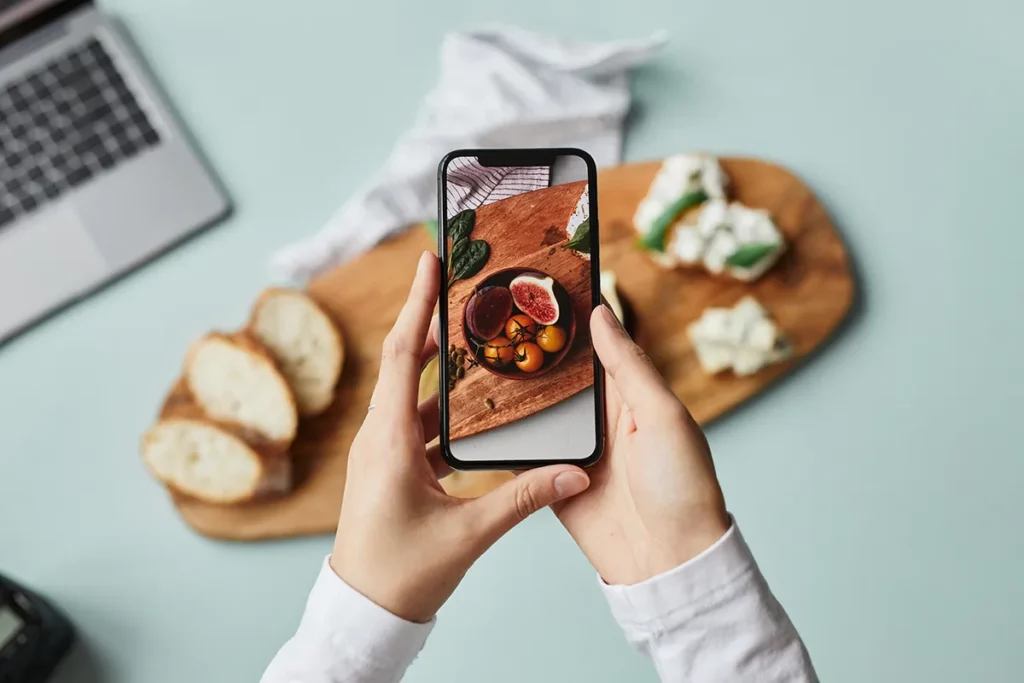
Strong Social Media Presence
The average person uses nearly seven social media platforms each month, so there’s ample opportunity to reach your customer base on them.
The best social media platforms for food businesses include:
These highly visual platforms allow you to showcase pictures and videos of your food to attract new and existing customers. They’re also an effective way to connect with customers directly by responding to comments and direct messages.
Here are a few other ways to leverage social media to your marketing advantage: